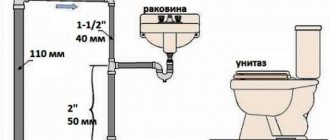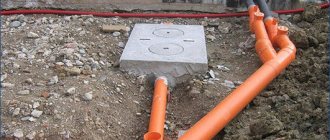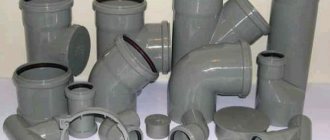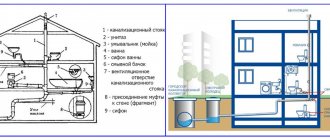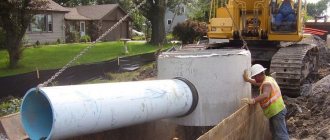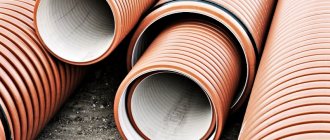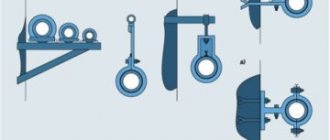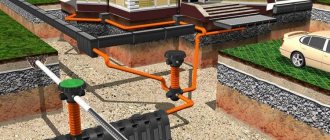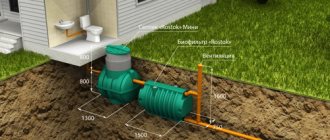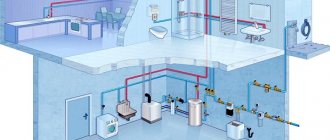After installing the sewer system, before moving on to finishing work inside and backfilling trenches outside, the drainage network must be tested to ensure the tightness of the nodes, pipelines and their connections. The external system and internal network are checked in various ways, regulated by the fundamental document of builders - SNiP. How to test the tightness of pipes and sewer connections by pouring, filling, and other methods, and what data is entered, if necessary, into the inspection report, you will learn by reading the article.
Work acceptance procedure
When accepting such work, the tests themselves are carried out first, which can be:
- Hydraulic - only non-pressure drainage systems are exposed to them, be it wastewater pipelines or storm sewers. testing is carried out in areas between wells by filling the system with process water. The tests are carried out in two stages - checking pipes and connections before filling the soil and checking the performance of the entire sewer system after filling the soil. Tests are carried out by pumping water into wells or receiving grids for 30 minutes; during the tests, the performance of the system is measured and the tightness of seams and joints is monitored. Tests may also be performed to determine the ability of pipes and connections to withstand the maximum allowable pressure throughout the entire drain.
- Pneumatic - during such tests, the ability of the waste system to withstand the design pressure is checked, according to GOST standards or design documentation. For such a series of studies, specialized organizations with the necessary equipment and licenses are involved; the process itself includes checking the pressure in the system or in its individual sections when supplying air under pressure.
If during the experiments the entire system met the standard indicators of SNIP 3.05.04-85, then an acceptance certificate for the work performed is drawn up, otherwise a defective statement and a drainage troubleshooting report are drawn up.
During periodic monitoring at enterprises with drinking water pipelines, external drainage systems are also tested during disinfection or treatment with special reagents.
Testing basic principles
The internal system includes the following objects:
- All plumbing points and household appliances that drain water;
- The entire pipeline connected to the central manifold;
- Central sewer riser.
The external test system includes:
- A pipeline placed outside a building to transport wastewater to a point of accumulation or disposal;
- All inspection and rotary wells;
- Storm drainage channels.
In order for the testing to pass efficiently and fully reflect the condition and performance of the sewer communication, it is necessary to adhere to the basic rules:
Thus, all plumbing points must be cleared of possible construction and natural debris before carrying out work; It is worth checking all points for cracks, chips and other damage; It is important to monitor the evenness of all straight sections of the network. There should be no deflections or bends; All vertical risers must be checked using a plumb line; To check the pipeline, you can use either a hydraulic method (spill method) or a pneumatic method (pumping the system with air); Important: drainage of sewer lines can only be carried out if the air temperature around does not fall below +5 degrees
If the outside temperature is below the specified parameter, then a pneumatic testing method is used. It is worth conducting a separate communication check for each floor of the building. To do this, audit plugs are installed on all other floors.
After installing the sewer system, before moving on to finishing work inside and backfilling trenches outside, the drainage network must be tested to ensure the tightness of the nodes, pipelines and their connections. The external system and internal network are checked in various ways, regulated by the fundamental document of builders - SNiP. How to test the tightness of pipes and sewer connections by pouring, filling, and other methods, and what data is entered, if necessary, into the inspection report, you will learn by reading the article.
The entire sewerage system in each building is divided into an internal sewage disposal network and an external sewerage system. Internal sewer wiring includes the following components to be checked:
- plumbing fixtures and their connections with outlet pipes;
- local sections of a horizontal pipeline with pipes flowing into it from plumbing fixtures;
- sewer risers;
- outgoing pipe.
In the external part of the sewer system, sections of the pipeline (between cleaning and auxiliary equipment) are tested for leaks, as well as:
- operability of wells, tightness and slope of the pipeline;
- condition of treatment or storage facilities (reservoirs);
- storm sewer.
Parties involved in the review
If we are talking about more or less large-scale construction, where several organizations are involved, not counting the customer, tests of sewer systems are carried out by all of them, after which the results are documented in the appropriate inspection report.
Typically, inspection of the sewerage system involves:
The official application from the bookmaker 1xBet is absolutely free and you can click on the link and place bets on sports.
- the organization that compiled the project and is responsible for the correctness of calculations and selection of materials and components;
- a company that analyzed climatic and soil conditions and made recommendations for the design of the external components of the sewer system;
- a contractor who was directly involved in installation work related to the laying of internal and external sewer networks and is responsible for compliance of the activities carried out with the project and existing requirements specified in SNiP;
- a customer who controls the correct testing of discharge pipes, connections and some functional units of the sewer network inside the building and in the external section of the wastewater disposal system.
Each of the representatives of the parties participating in the tests and signing the final inspection report is responsible for inaccuracies and shortcomings that arose during testing of sections of the system, individual nodes or the entire network as a whole.
Testing the drainage system outside the building
In most cases, external sections and nodes of the sewer network are carried out hydraulically (except for the mentioned situation with low air temperatures). Test objects are:
- pipeline (tightness, slope);
- operability of differential and rotary wells;
- condition of storm sewers (tightness of gutters, drains, ability to drain a given volume of water per unit of time).
The outlet hose is tested like an internal pipeline (spill, compressed air). In pressure sewer networks, the integrity of connections and pipes is checked under pressure. The test is considered positive if the pressure at the inlet and outlet of the system is the same, which indicates the absence of leaks.
Wells are tested by filling them with water. A filled tank with hermetically sealed inlet and outlet openings should not form leaks, that is, the water level in the well should be constant over a certain period of time. Testing of other structures included in the external sewer system (cesspools, septic tanks) is carried out in a similar way. The results of the tightness test are reflected in the report.
Storm sewerage is checked as follows:
- the drain into the common outlet pipe is sealed;
- the system is filled with water (horizontal drains around the perimeter of the roof, vertical drains);
- the result is taken into account after 10 minutes (for metal systems) or after 20 (for plastic);
- a positive result of testing the storm drain is included in the inspection report if the water level has not changed and leaks are not visually detected at the junctions of pipes and fittings.
It is necessary to test the sewer system before starting finishing work inside the building and filling trenches and pits outside. Testing allows you to timely find and correct defects made during the installation of sewer pipelines and structures. Operation of the sewerage system is possible if in the final document (inspection report) all tests carried out in accordance with SNiP were successful.
After completing all installation work on the sewerage system, it is necessary to test the communication using the spill method. This is done in order to identify defects in the installation of drains, channels, sewer outlets, internal drainage systems, etc. The result of the inspection is included in the act, the form of which is approved by SNiP (Appendix “D” SP 73.13330.2012 “Internal sanitary systems of the building” - updated version of SNiP 3.05.01-85). A similar document in everyday life is called “Act of spillage of the sewer system”; in narrow circles of professionals, the same document has the official name “Act of testing of internal sewerage systems and drains”.
This stage of construction of sewerage communications is mandatory and cannot be cancelled. The verification activities themselves are carried out using the full spill method, provided that at least 75% of the drain holes are opened in a single period of time.
Below in the material there is an example of how to correctly fill out the document.
To identify defects in the operation of the sewerage system, a series of tests are carried out, which includes:
- Checking the operation of the internal part of the communication using the spill method;
- Full check of the tightness of all pipeline joints along its entire length;
- Identification of possible defects in the operation of all sewerage wells (inspection, rotary, inspection, etc.);
- Storm sewer testing.
Exam for domestic sewage system
Checking the correct installation of the internal sewage system and examination are carried out before starting interior finishing work. Testing is carried out using the spill method. Sections of the network - pipelines laid in underground channels or in the ground - are tested by pouring water to the same level as half of the first floor. All areas of internal TP are tested before they are closed during subsequent work.
Composition of the internal sewerage system
The internal sewerage network includes the following objects: plumbing fixtures (bathtubs, sinks, shower trays, toilets and connected household appliances from which water is drained into the sewer network, etc.), shut-off valves, sewer risers, pipelines connecting sanitary technical devices with risers.
Visual inspection of internal sewerage network elements
All elements of the internal sewer network must be made of high-quality parts and correctly connected. All plumbing fixtures must be connected to the TP via siphons. Pipes - go at a slope towards the riser. The sockets of the connecting elements (this does not apply to couplings) must open towards the water flow; connection to the pipeline is allowed at an angle of up to 45 degrees. The diameter of the pipes along the main line along the flow may increase, but not decrease. The fan pipe must have a diameter no smaller than the riser, and the riser must be strictly vertical. All plumbing fixtures, tie-ins and connections must be in the places specified in the project and at the height specified by the standards. Checking for all of these conditions is part of your indoor plumbing inspection.
If all these requirements are met, it is checked whether there is construction debris in the line. If there is debris, the pipeline must be cleaned.
Pipeline flow test
Since the internal sewage system is gravity-flowing, that is, free-flowing, the strength of the pipes and the tightness of all connections are checked by spilling. This is done simply. The inspected section of the “bed” (part of the main TP) is fenced off using plugs installed in revisions from the rest of the network and filled with water through the pipes of plumbing fixtures. According to SNiP, tests are considered correct if 75% of the plumbing fixtures connected to this section were involved in the filling. If within 10-15 minutes (from the moment of filling) the connections of the tested area do not leak, the exam is considered successfully passed. However, to carry out testing using the spill method, an air temperature of at least 5⁰C is required. If this condition is not met or there is no water, a pneumatic test is carried out.
Pneumatic exam
This is a test of connections by injecting compressed air into the network. For polymer pipes the pressure is 0.05 MPa. It is maintained in the TP for 15 minutes. At this time, all connections are inspected. For control, a soap emulsion is applied to the joints of the parts. When passing through it, the escaping air bubbles become visible. You can also determine the release of air by sound. If no leaks are observed, the system is considered to have passed the test.
Hydraulic testing of pipelines and commissioning
Testing of water supply, sanitation
The installed pipeline is subject to testing for strength and density (tightness) using a hydraulic method. The maximum length for testing a pipeline made of cast iron pipes in one step should be no more than 1 km, with longer lengths in sections of no more than 1 km.
The length of test sections of pipelines during hydraulic testing is allowed to exceed 1 km, provided that the permissible flow rate of pumped water should be determined as for a section 1 km long.
Pipeline testing should be carried out in 2 stages:
— preliminary testing for strength and tightness, performed after partial backfilling of the pipeline;
— final (acceptance) test for strength and tightness, performed after the pipeline is completely backfilled.
Both stages of the test must be performed before installing hydrants, plungers, and safety valves, in place of which flange plugs should be installed during the test.
The values of the internal design pressure Рр and test pressure Risp for carrying out preliminary and acceptance tests of the pressure pipeline for strength must be determined by the project and indicated in the working documentation.
Before starting the hydrotest, you should check and make sure that the air has been completely removed from the pipeline presented for testing. It is recommended to fill the pipeline with water from the lower side of the site. When testing a pipeline for strength, the following operations are performed:
— gradual increase in pressure in the pipeline (3-5 kgf/cm2) with holding the pressure at each stage for at least 5 minutes and inspecting the pipes and butt joints;
— if a leak is detected during an increase in pressure, it is necessary to establish the cause of the leakage and take measures to eliminate it; Elimination of detected defects in the pipeline can be carried out after reducing the pressure in it to atmospheric pressure;
— it is strictly prohibited to walk along the pipeline being tested, tapping, tightening bolted joints, or having workers in the trench;
— when the pipeline reaches test pressure Rsp for at least 10 minutes, do not allow the pressure to drop by more than 1 kgf/cm2, performing additional pumping of water to Rsp.
The pipeline is considered to have passed the strength test if, when the test pressure is reached, no pipe rupture occurs in it, butt joints are not broken, and no water leaks are detected during inspection of the pipeline.
Specifics of drawing up a test report
Regardless of the type and method of verification, the document must contain the following points:
The header of the document, which should indicate the date of preparation and the city in which the document is drawn up and signed. Indication of the city is mandatory, since the signing of the act may occur outside the locality where the installation or repair of the water drainage system was carried out.
Also in this part of the document the name of the organizations and the full name of the managers must be indicated, as in the charter of the organizations that carried out control, testing and technical or designer supervision of the progress of work.
Also in this paragraph there should be footnotes on the design marks and coordinates of the sewage system, in accordance with the general plan or special sections of the construction project.
Sample of filling out the document header
After the header of the document there is an extract from the technical conditions according to which the experiments were carried out. This section contains calculation formulas, a list of necessary test equipment, conditions and procedures for carrying out work.
When filling out this item, data taken from measuring instruments during research are used. If the act itself does not contain this section, then there should be a link to the test report, which describes the process in detail and all calculations are made. All results can be summarized for convenience in a single table.
Sample of filling out the measurements and calculations section
The last item is the decision of the commission, which indicates the result of the tests and the conclusion that the drain system is ready to be accepted into operation. In case of discrepancy, the reason is indicated and links to defective statements and acts for correction and revision are provided.
If the pipeline has passed all tests, the full data of all members of the acceptance committee and their signatures are indicated, after which this document becomes the basis for drawing up a statement of disagreements or a statement of work performed, according to the conclusion of the expert commission.
An important condition for the preparation of this document is the procedure for vesting powers in the members of the commission, for which the necessary orders of managers must be created. Also important are the certification documents of all members of this commission, confirming the qualifications of the participants to conduct research or monitor the progress of its implementation.
Specifics of drawing up a test report
Regardless of the type and method of verification, the document must contain the following points:
The header of the document, which should indicate the date of preparation and the city in which the document is drawn up and signed. Indication of the city is mandatory, since the signing of the act may occur outside the locality where the installation or repair of the water drainage system was carried out.
Also in this part of the document the name of the organizations and the full name of the managers must be indicated, as in the charter of the organizations that carried out control, testing and technical or designer supervision of the progress of work.
Also in this paragraph there should be footnotes on the design marks and coordinates of the sewage system, in accordance with the general plan or special sections of the construction project.
Sample of filling out the document header
After the header of the document there is an extract from the technical conditions according to which the experiments were carried out. This section contains calculation formulas, a list of necessary test equipment, conditions and procedures for carrying out work.
When filling out this item, data taken from measuring instruments during research are used. If the act itself does not contain this section, then there should be a link to the test report, which describes the process in detail and all calculations are made. All results can be summarized for convenience in a single table.
Sample of filling out the measurements and calculations section
The last item is the decision of the commission, which indicates the result of the tests and the conclusion that the drain system is ready to be accepted into operation. In case of discrepancy, the reason is indicated and links to defective statements and acts for correction and revision are provided.
If the pipeline has passed all tests, the full data of all members of the acceptance committee and their signatures are indicated, after which this document becomes the basis for drawing up a statement of disagreements or a statement of work performed, according to the conclusion of the expert commission.
An important condition for the preparation of this document is the procedure for vesting powers in the members of the commission, for which the necessary orders of managers must be created. Also important are the certification documents of all members of this commission, confirming the qualifications of the participants to conduct research or monitor the progress of its implementation.
> Sewerage test report for spillage
Who is responsible for the functionality of the sewer system?
The commission inspecting the sewer network includes representatives of:
- the company that designed the system. This organization is responsible for the correctness of calculations and drawing up drawings of the sewerage network;
- organization that carried out research in the area where sewerage installation was planned. This company is responsible for the accuracy of the data regarding climatic conditions and environmental conditions on the basis of which the system design was developed;
- companies involved in laying sewer networks are responsible for the quality of work and compliance with existing standards;
- customer organization. Controls all stages of construction. Responsible for the correctness of the inspection when putting the sewer network into operation.
Each organization has its own area of responsibility, the boundaries of which are clearly defined. After the inspection, all members of the commission sign a test report for the sewerage system.
Form of the act recommended by the legislation of the Russian Federation
Testing basic principles
The internal system includes the following objects:
- All plumbing points and household appliances that drain water;
- The entire pipeline connected to the central manifold;
- Central sewer riser.
The external test system includes:
- A pipeline placed outside a building to transport wastewater to a point of accumulation or disposal;
- All inspection and rotary wells;
- Storm drainage channels.
In order for the testing to pass efficiently and fully reflect the condition and performance of the sewer communication, it is necessary to adhere to the basic rules:
Thus, all plumbing points must be cleared of possible construction and natural debris before carrying out work; It is worth checking all points for cracks, chips and other damage; It is important to monitor the evenness of all straight sections of the network. There should be no deflections or bends; All vertical risers must be checked using a plumb line; To check the pipeline, you can use either a hydraulic method (spill method) or a pneumatic method (pumping the system with air); Important: drainage of sewer lines can only be carried out if the air temperature around does not fall below +5 degrees
If the outside temperature is below the specified parameter, then a pneumatic testing method is used. It is worth conducting a separate communication check for each floor of the building. To do this, audit plugs are installed on all other floors.
During testing of external sewerage using the spill method, the same document is drawn up as during testing of the internal sewage system. The form of the act itself is not a form of strict reporting and can be drawn up by the customer, contractor or subcontractor.
Also, during experiments on an external water drainage system, one of the forms of SNiP 3.05.04-85 can be used, which is a general form of document for acceptance of work performed when installing or repairing a drainage system.
What to check
Checking the functionality of the sewer system includes:
- testing of the internal sewerage system;
- checking the tightness of pipelines;
- determining the performance of wells;
- storm drain testing.
What applies to the internal sewerage system
The internal sewer network includes:
- plumbing products, including household appliances that drain water;
- internal pipelines connected to a common sewer riser;
- central sewer riser equipped with a drain pipe.
Internal sewage system
What applies to the external sewerage system
The external part of the sewer network includes:
- pipelines carrying wastewater from the house to the disposal site;
- wells that need to be installed at junctions, branching pipes or differences in network height;
- wastewater treatment plants;
- storm drains and storm water inlets.
External sewage system
Testing of external sewerage networks
Preliminary tests Acceptance tests Pneumatic tests Preliminary tests Hydrostatic pressure in the pipeline during its preliminary testing must be created by filling the riser installed at its upper point with water, or by filling the upper well with water, if the latter is to be tested. In this case, the value of hydrostatic pressure at the top point of the pipeline is determined by the amount of excess of the water level in the riser or well above the pipeline shelyga or above the groundwater horizon, if the latter is located above the shelyga. The magnitude of hydrostatic pressure in the pipeline during testing must be indicated in the working documentation. For pipelines laid from free-flow concrete, reinforced concrete and ceramic pipes, this value, as a rule, should be equal to 0.04 MPa (0.4 kgf/cm2).
Testing of external network Testing of external sewerage is carried out mainly by hydraulic method. Work performed:
- pipeline slope control;
- the pipeline is tested for leaks;
- examination of wells and other equipment.
The slope level of the external sewer is checked by level.
The test is carried out between wells, in stages, each section is disconnected from the system using a plug. Test scheme for non-pressure systems::
- checking pipes for blockages and debris from construction, and flushing if necessary;
- spill test - a section of the system is filled with water; if no leaks are detected within 10 minutes, the test is passed.
Water is supplied to the pressure sewer under pressure. If the pressure at the inlet and outlet of the pipe is the same, the test is also considered passed.
The check includes:
- testing the pipeline for leaks (carried out as described above. For testing, sections of pipes located between wells or other elements of the system are taken);
- checking the pipeline slope level;
- testing of wells and other equipment;
- checking the performance of storm drains.
A level is used to check the level of pipe laying required for a gravity sewer system.
If a pressure sewer test is being carried out, then water must be supplied to the pipeline system at the pressure specified in the design documents. The test of pressure sewerage pipelines is considered successful if the pressure value in the flow into the network and at the exit from it is the same.
Testing the internal sewer network
When carrying out test work, it is required to be guided by SNiP “Sewerage. External networks and structures.” According to this document, the following is checked:
- compliance with the developed project;
- testing sewerage pipelines for strength and reliability of joints;
- correctness and reliability of installed devices and flushing elements;
- verticality of mounted risers.
Testing of nodes
Compliance with the design is checked visually. Each element of the system must be located exactly in the place where it is indicated on the plan or drawing.
An example of a layout of devices inside the house
All installed devices must be cleared of debris and thoroughly washed. They should not have visible damage (chips, cracks, etc.) or bending. When installing devices, deflections must not be allowed.
The risers are checked for verticality with a plumb line.
The verticality of the risers is checked with a plumb line
Pipeline testing
Pipeline inspection can be carried out hydraulically or pneumatically.
A hydraulic sewer test involves pumping the system with water, and a pneumatic test with air.
If the house has more than one floor, then the system is checked on each of them separately. To temporarily disconnect a floor from the general sewerage system, plugs are used that are inserted into the inspection.
Plugs are used to temporarily disconnect parts of the sewer system.
Pipeline testing is carried out according to the following scheme:
- All pipes are checked for blockages and construction debris. If necessary, they are washed;
- Horizontal sections of the pipeline undergo drainage testing. To do this, at least ¾ of all drains are opened. The fenced off section of the sewer system is completely filled with water. If no leaks are detected within 10 minutes of operation, the test is considered passed;
- to check vertical sections of the pipeline, water is supplied under pressure not exceeding 0.08 MPa. The sewerage test for the tightness of pipelines is completed if no leaks or ruptures in the system are detected within 15-20 minutes.
Example of pipe leaks
